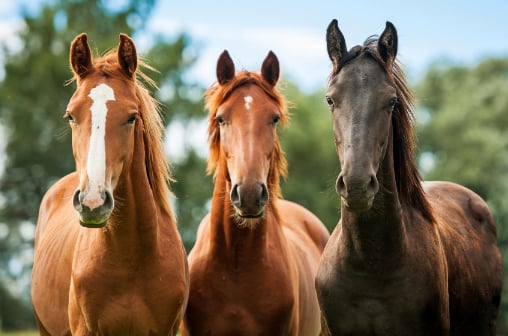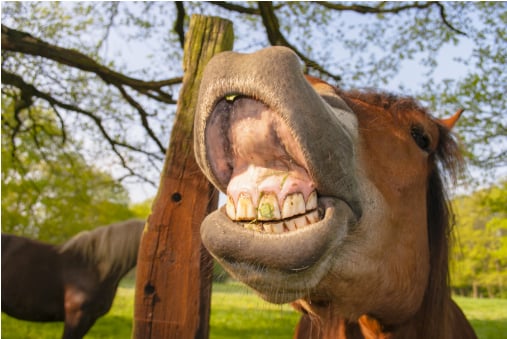We’ve talked about how the horse’s biology is not suited to the meal-based feeding schedules we so commonly keep them on. We’ve also explored how modern feeds and even hays are not optimal, and often harmful, for the horse’s digestive process. So far, I’ve mostly only told you what doesn’t work. Let’s get into a few of the options you have for what does work.
I would like to state that I am not a certified equine nutritionist, a vet, or a medical professional of any kind, and that any information I present here is a matter of researched opinion only. I am very open to discussion, debate, and correction, and absolutely do not recommend that you take my word for gospel, or alter your feeding plans without doing your own reading and consulting a professional you trust.
Part 3: Why not feed your horse like a…horse?
#1 Consider free choice.
Free-choice feeding is just that, giving the horse full freedom to eat, or not eat, as he desires and as his hormones and stomach dictate. It can look a lot of different ways depending on your needs and set-up, but the general idea is that the horses are never without food. Check out this article by Dr. Juliet Getty before you open your mouth to say “But…they’ll blow up like blimps!” What if the body, every body, had the natural wisdom to eat what it needed, when it needed, so long as conditions supported that wisdom? Wild horses, given that times are not tough, live on free-choice forage. They rarely founder, are almost never obese, and do not develop obsessive or stereotypic tendencies.
#2 Get your hay tested.
A ziplock full of your latest batch of hay can be taken to your local vet and sent off for testing. Cost varies with clinics, but is almost always low enough to be very worth it. You’re looking for Non-Structural Carbohydrates (NSC) to be lower than 12% if your horse specifically requires low-carbohydrate hay. With healthy horses, you might get away with higher percentages, but make sure you keep track of what you’re feeding and how your horses react. Here’s a quick guide to interpreting your hay analysis reports.
Lucky for those of us in the Lower Mainland of BC, we have our very own low-sugar, unsprayed horsey hay grown right here in Chiliwack. Gordon McEachren of Bailey Hay Sales has been tinkering with his hay fields for 19 years to bring concerned horse owners high-quality, very low-carbohydrate forage for an affordable price. I’ve bought his second and third cuts this year, and they test at under 11% NSC. Our horses love the stuff, and often choose it over sweeter hay. Gordie provides a full hay analysis with every delivery, and has incredible customer service. Give him a shout at 604-858-4895.
For the less fortunate, you’d better start kicking up a fuss. Ask your farmers and your feed stores to test their hay, and ask (and keep asking!) for low-sugar options. Create the demand, create the market. As long as we keep buying cow hay, they’ll keep making it.
#3 Look into slow-feeder systems.
This is a project in and of itself, but lucky you, I and many others have been researching and testing different systems. Here’s our slow feeder design comparison where we give you the low down on nets, grates, plastic, metal, etc.. The basic premise is that the hay is contained in some sort of vessel or material that allows limited but constant access to feed, slowing down the speed at which our efficient equine friends inhale/gobble/wolf down their hay! This also helps regulate their systems as it mimics (as best it can) the slower pace at which food is ingested in free-roaming scenarios (imagine a horse picking a few blades of grass at a time, chewing, and then picking some more as he swallows – now imagine your horse at feeding time with a flake of loose hay after waiting for it for hours).
After weeks of research, and looking at budgetary constraints, I settled on the simple option of hay bags, of which there are many models. My boss and I bought EcoNets, from Alberta, but there’s also NagBags in BC and endless other options if you want to do some hardcore shopping.
If you’re considering slow-feeders (did I mention they reduce waste, and help keep a free-choice system tidier?), make sure you figure out what size of hole you’ll need, and how to introduce your horses to this strange new contraption.
#4 Keep learning.
There are so many resources around the topic of feeding your horse naturally. Some of them might contradict each other, but it’s up to the horse owner and the horses to decide what works best. Some links to get you started, though:
– Kathryn Watts – the leading resource for education on grass and hay, and how best to feed your horse
– Riva’s Remedies – based in Armstrong, BC, founder Marijke Van de water’s business is all about equine nutrition and natural herbal supplementation based on a comprehensive understanding of horses’ digestive needs. Here you’ll find support and products for all manner of health issues, as well as Marijke’s extremely helpful book, Healing Horses: Their Way!
– Dr. Getty’s book on low-sugar, free-choice horse feeding, Feed Your Horse Like a Horse: Optimize Your Horse’s Nutrition for a Lifetime of Vibrant Health
The system we’ve been testing at Healing Heart Sanctuary is a combination of the above points. We use Gordie’s lovely low sugar hay in our EcoNet hay bags, one per horse plus two large community feeders. We fill them once or twice a day and make sure there’s always food. Our herd could barely believe their luck when we implemented this system. Food aggression is way down, and we have no more wood-chewing, anxiety, or other stereotypic behaviour. The horses are always ready to work or play, now that they know the food is always there. Our more sensitive horses are stabilizing noticeably in weight and energy. It’s an all-around success, but I keep watching for ways I might improve it.
Currently, it does cost more to feed this way. We’re still in early days yet, so we’ll see how this trend plays out. Meanwhile, all the horses and all the owners agree – free-choice, low-sugar slow-feeding is totally worth it.
If you missed the first two posts, you find Part 1 here, and Part 2 here.
A barefoot hoof trimmer, a singer/songwriter, an amateur farmer – these are some of the hats Kesia Nagata wears when she’s not full to bursting with wondrous equine co-creation.










Excellent article AND references!
LOVE the EcoNets Kesia. However, I also just finished reading Jamie Jackson’s PADDOCK PARADISE and at this point his system does look to be ideal – both for feeding and hoof health.
Horses are kept walking all day around a “track” that maximizes your pasture layout (can be done with only 3-5 acres), takes advantage of natural and varied terrain, and hay is placed at intervals along the length of the track.
But people have also taken Jackson’s idea and been customizing it. Here’s a farm in Kauai that is combining the hay nets idea with the walking track idea. I have to say though, I don’t like the angle of their heads/necks as they have to get the hay out of the bottom of the barrel…. looks like a physio adjustment waiting to happen!
http://youtu.be/UlJTG979_-8
Love Paddock Paradise set-ups, they are, I think, as good as it gets when we have to control our horses’ environments. Hay bags + tracks = most of your nutrition and exercise bases covered! They also create conveniently limited grazing opportunities for horses that can handle some grass.
The problem with almost all feeders is that, yeah, like in this video, they change the angle at which horses eat. There are SO MANY innovative ideas for feeders and ways to hang and attach nets (or for making your own custom systems), my brain just about exploded while researching them. Ultimately, a head-down grazing position is optimum for teeth, posture, and musculature, so that’s what we should eventually aim for. Still, using some kind of slow-feed/free-choice system is going to be your first step in optimizing your horse’s nutrition and well-being. How you decide to do that might take some experimenting!
Interestingly, I did attend a talk on hoof-care that touched on Jamie’s system. These researchers attached GPS collars to horses in different sized fields, and fields with electric fencing creating tracks. Though track-kept horses did move around more in the day time, the GPS showed that they spent more time standing still in the night, possibly because they were worried about hitting the wire in the dark. All in all, the horses on ten empty acres, with no track, actually moved more than horses on ten acres fenced into a track. Still, I wondered if, had they done longer-term studies, after horses had grown to know their new environments, they might see different results. I’d like to see horse owners trying this themselves (GPS devices can be very cheap and fairly noninvasive) and comparing their results, as I don’t think the study took enough into account.
WOW I had not heard about the GPS experiment – I wonder if Jamie Jackson has? I had 3 horses on 8 acres in Alberta (free range) and they ate themselves fat in summer, normalized in winter (hay-fed). All were barefoot with great hooves, no founder, no laminitis, no colic over the course of a decade. All could run on gravel, trail ride through the forest, etc. with no soreness AND without trying to eat along the ride that you get with many horses. They had no anxiety about food whatsoever.
My friend in New Jersey – which has rich grass like BC, puts her horses out to pasture overnight (lower sugar content in grass) and keeps them in a 1/2 acre paddock during the day, with hay.
I think there are always ways to get your horses a more natural feeding experience, no matter what the conditions, as long as you’re willing to try things – like you’ve been doing. I can’t think of any horse owner who would choose NOT to slow-feed just because it costs a bit more. Whatever extra you paid in feed, you would save at least double in vet bills!
Pingback: Tough-1 Heavy Denier Nylon Hay Bag Tote Black Tooled Leather New |